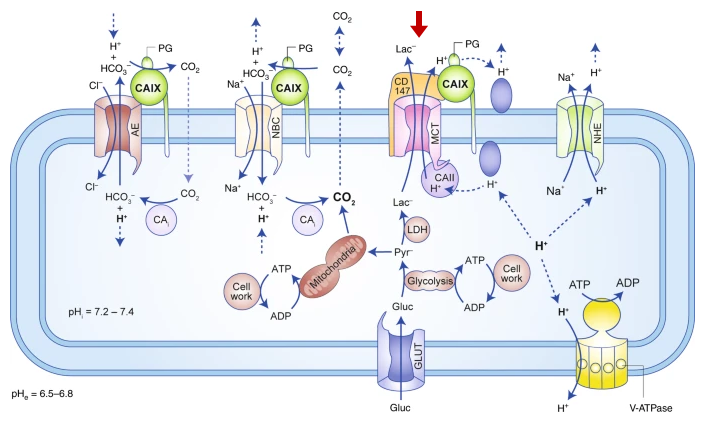BIOHACKING by Nathan Hatch, "F*** Portion Control"
-
@evan-hinkle FWIW his user name was natedawggh I believe, not natedawgg
-
@evan-hinkle but if you are able to hover over his profile picture and you get a "last seen" status, then he is still on the forum....(which you can in his case)
-
This post is deleted! -
@tubert interesting, wonder if he was unbanned? Either way, his posts seem to be intact. Thanks
-
@S-Holmes 12 Jan 2021
-
This post is deleted! -
-
This post is deleted! -
Sate's experiences are valid, but he misinterprets them.
Try to approach his material from now on with suspicion and verify claim by claim. I'm not insinuating that you may encounter a series of absurds in his explanations, I'm guaranteeing it.
It's a bimonthly discovery of the ultimate cure for a multifactorial disease or problem. He could measure words when dealing with cancer-related topics because people may come across the content in critical situations, desperate, and waste valuable time putting their hopes on quackery.
What we have this time:
- Supplemented silicic acid
- Felt a "sense of relaxation"
- Assumed that he was stuck in glycolysis
- Found an experiment with isolated mitochondria bathed with silicic acid
- Concluded that silicic acid rescued him by protecting mitochondrial electron flow through insulation*
- Extended the discovery to humanity
- Announced to the world
*"I was not prepared for how fast [bamboo silicon with lemon juice, followed by some fruit and cake] would work and within 45 minutes my migraine had entirely disappeared and I was back at my computer doing research and listening to music, confirming my discovery of silicon’s role in mitochondria energy production and insulation against electron leakage from the electron transport chain. So this is also the cure to migraine[.]"
It's our daily dose of madness.
Silicon is absorbed past the gut site where pancreatic alkalinization occurs. The pH is raised to a standard as the stomach is emptied. This alkalinization doesn't prevent its absorption:
It's the people with low stomach acids that don't have a sufficient stimulus for adequate pancreatic alkalinization: if keeping the digesta more alkaline throughout the digestive tract was an issue, this could represent an advantage.
When food enters the stomach, the pH is temporarily raised to achlorhydric levels as well, but subjects absorbed silicon anyway.
We can suppose that the acidification was meant to keep the pH low only in the stomach to minimize aggregation of high doses of silicic acid in free form. However, aggregation is not instantaneous, an "induction period" exists and only then it starts to occur. The graph below doesn't show this period, with a S-shaped (sigmoid) curve, but illustrates how it's not much affected early on.
Polymerization and Complexation Behavior of Silicic Acid: A Review
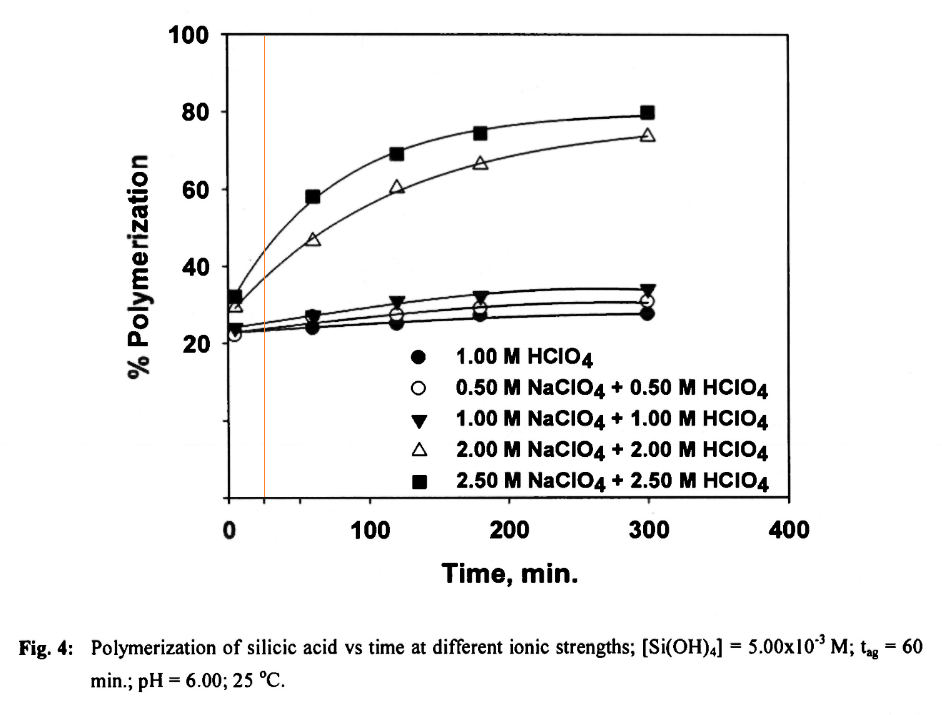
The temperature would be higher, but the concentrations of salts would be lower, rich in HCl, which they found to be less effective in promoting aggregation (or polymerization).
Stomach emptying of liquids might be almost complete by the time that aggregation starts to concern:
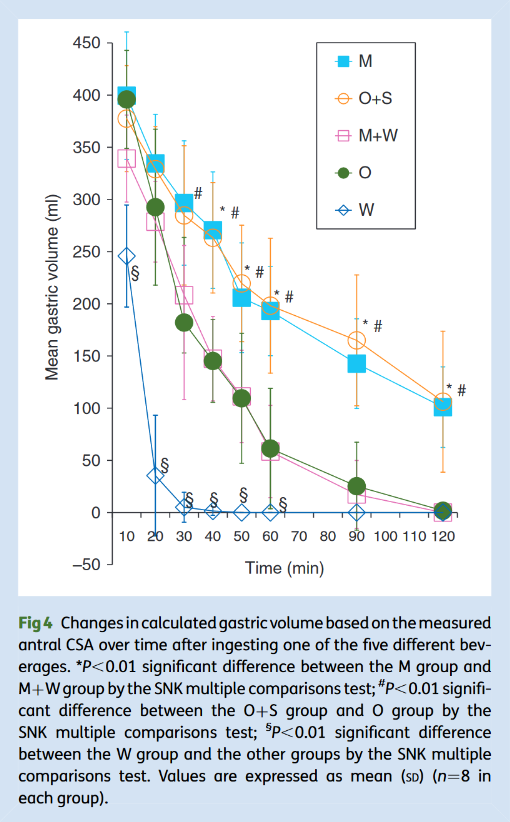
- M group: 500 ml of non-human milk (330 kcal)
- O+S group: 450 ml of 100% orange juice + 50 ml of gum syrup (total: 330 kcal in 500 ml)
- M+W group: 330 ml of non-human milk + 170 ml of water (total: 220 kcal in 500 ml)
- O group: 500 ml of 100% orange juice (220 kcal)
- W group: 500 ml of water (0 kcal)
ㅤ
Recipes aside, the authors of the sole supportive material linked in his article noted that an increase in mitochondrial respiration came after swelling. The presence of silicic acid promoted salt permeation and accumulation, which would explain the effect.
They showed traces of it primarily on the outer membrane region, away from where oxidative phosphorylation occurs, and even less in the matrix of mitochondria; with no indications that silicon was behaving as a membrane insulator--quite the opposite.
On the generation of unwanted reactive oxygen species that he brought up, once electrons are transfered from donors to acceptors at this stage of respiration, they're channeled through the respiratory complexes (and fatty parts), that do contain water molecules within, but most of the water is excluded along with soluble silicon. Oxygen has low solubility in water, so if silicon was working as an insulator, it wouldn't prevent an undesirable reaction.
Recall that these were isolated mitochondria bathed in artificial conditions and exposed to 290 mg orthosilicic acid/L: good luck achieving this level ingesting 400-700 mg at a time. Its complete absorption would result in dilution in 5 liters of blood and some more volume between cells. It wouldn't peak high because uptake occurs in fractions and it wouldn't be elevated for long due to clearance. And we can't forget that the dose would have to overcome the cell barrier, be further diluted in the cytosol, before it can reach non-isolated mitochondria in the body. In the experiment, lower silicon concentrations led to a proportional decrease in uptake and any effect must lessen along.
Sate's description can make readers picture silicon lining the mitochondrial membranes orderly as the plastic coat on copper wires (yes, he regarded it as an insulator thrice), but what this guy is trying to prevent with acids (acidification to avoid aggregation) may occur in cells, where the pH is steady, on the alkaline side and he can't manipulate. The molecules can cluster into granules, that are measured in diameter.
Silicon-Containing Granules of Rat Liver, Kidney
and Spleen Mitochondria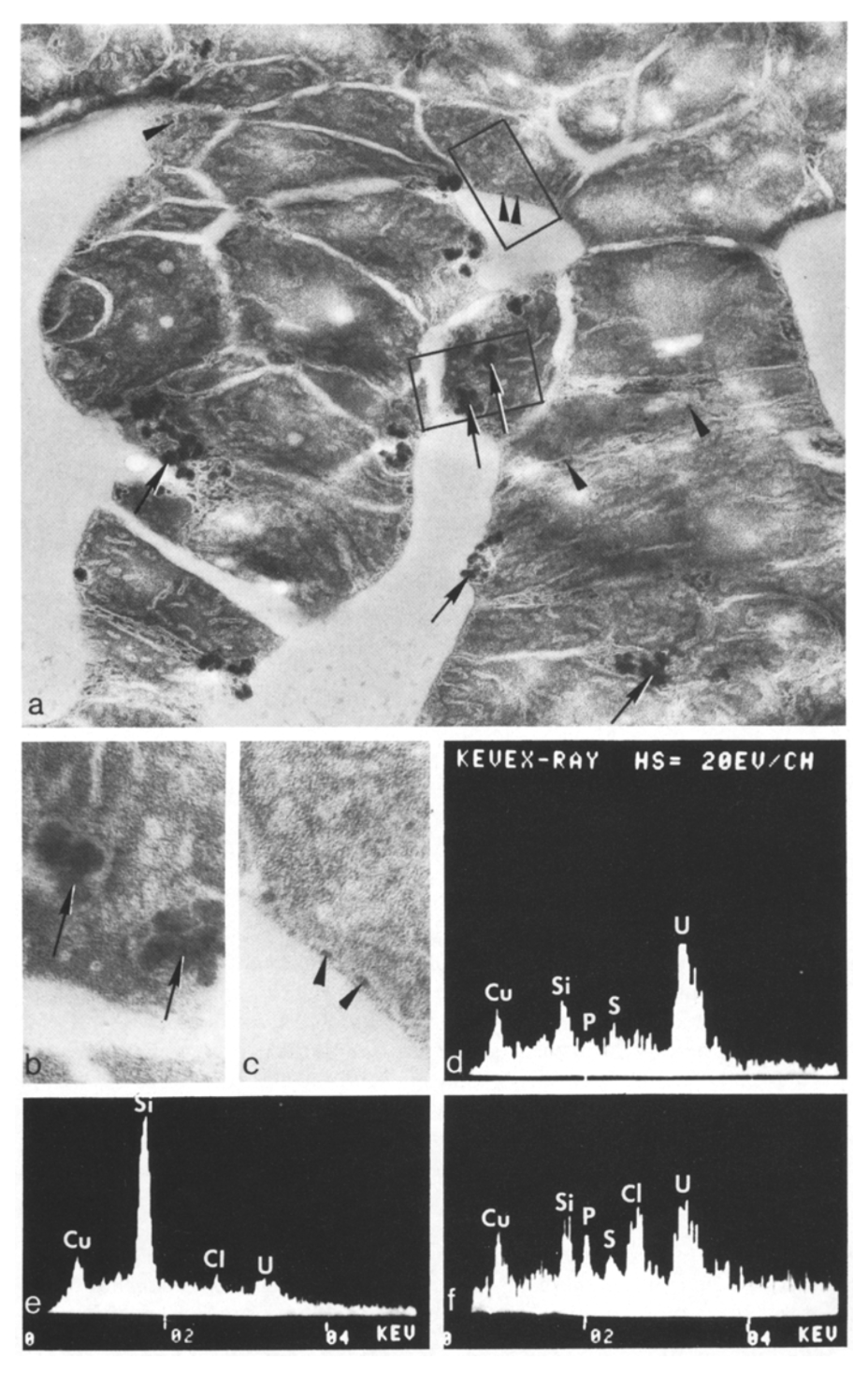
Fig. 1 (a-f). Isolated rat liver mitochondria and in situ granules. Thin sections (100nm), surface-stained with 5% uranyl acetate only, for X-ray analysis; for transmission microscopy stained with uranyl acetate and lead citrate.
- a) Portion of compacted mitochondrial pellet showing mitochondria without granules, with granule aggregates (long arrows), and small granules (arrowheads); × 30,000.
- b) Enlarged areas of a showing granule aggregates; × 100,000.
- c) Enlarged area of a showing small granules; × 100,000.
X-ray spectrograms (d-f) taken from another section;
- d) mitochondrion without granules;
- e) granule aggregate (25-75 nm);
- f) small granule (5-10 nm)
It may be speculated that these were drained preformed from the gut or airways, but it's also possible for them to form locally from the aggregation of silicic acid, as the authors of the experiment suggested. Other minerals are present to help clustering despite the low concentrations. So, its even distribution is also questionable.
Overall, without examining the issue in depth, we can already poke holes in his outrageous claims.
The 'last seen' information only shows the most recent access with the account, independent if it's banned or not. For example, when people enter to take screenshots of their banned accounts, it's registered and appears to others as a regular visit.
I don't know what happened to this guy, but the lion mentioned that inactive members disappear from the search menu. The username has to be typed manually and exactly as it occurs.
-
He's claimed to have read much much research but it's how one interprets it. Not to mention the actual quality of the research.
He's interesting enough to read and many of his ideas seem easy enough to try imho.
And last but not least, what has worked for him may not work for everyone else, obviously.
-
This post is deleted! -
@BioEclectic said in BIOHACKING by Nathan Hatch, "F*** Portion Control":
He's claimed to have ready much much research but it's how one interprets it. Not to mention the actual quality of the research.
He's interesting enough to read and many of his ideas seem easy enough to try imho.
And last but not least, what has worked for him may not work for everyone else, obviously.
He claims many things, might have read a lot, but the quality is lacking in my opinion.
Remember when not long ago he discovered that the cause of hyperphosphatemia is an oleic acid deficiency? Of course, the remedy being olive oil. It's atrocious.
It's also a shame that we have serious authors who deserve more recognition, while this guy gets free publicity when people fall for the sensationalism and spread senseless concepts as legitimate.
-
This post is deleted! -
This post is deleted! -
@S-Holmes said in BIOHACKING by Nathan Hatch, "F*** Portion Control":
@Amazoniac Umm, what am I missing? Who is Sate?
A variation of Nate.
@S-Holmes said in BIOHACKING by Nathan Hatch, "F*** Portion Control":
How to make use of silicic acid is just one tiny section out of about 500 pages.
@S-Holmes said in BIOHACKING by Nathan Hatch, "F*** Portion Control":
@Amazoniac Just curious. Have you read his book?
Yes, when it was distributed for free. It's a collection of articles, similar to those that have remained publicly available.
-
This post is deleted! -
@S-Holmes said in BIOHACKING by Nathan Hatch, "F*** Portion Control":
@Amazoniac I'm testing his ammonia lowering strategies right now. Being a canary in the coal mine (kind of like him) I should know pretty soon whether they work or not.
I'm not opposed to him sharing his experiences for others to try, but he has to be more careful in interpreting them and it doesn't hurt to give hints of uncertainty when he's clueless.
-
This post is deleted! -
@Amazoniac Thanks for the thorough explanation.
It's over my head, but I got some of it.
-
@S-Holmes said in BIOHACKING by Nathan Hatch, "F*** Portion Control":
@Amazoniac Actually, that was one thing that impressed me. He said by having the digital version we would get updates and corrections because he's certain he isn't right about everything and will let us know when changes are made. I don't sense any ego in his work.
No ego? Good one. Just the title of the article in question is enough to refute the impression:
- I SOLVED THE WARBURG EFFECT (
ATHE CURE FOR CANCER)
It's somewhat irresponsible of him to not curb the grandiose, in special when dealing with cancer. And it wouldn't be difficult:
- Silicon in mitochondria: effects on cellular respiration with relevance for cancer metabolism [if it wasn't junk]
To put into perspective, check these out:
- Metabolism of ketonic acids in animal tissues
- The role of citric acid in intermediate metabolism
in animal tissues - The formation of citric and α-ketoglutaric acids in the mammalian body
Despite the composure, they're Hans Krebs' original works on the TCA cycle.
- I HAVE WORKED OUT THE CITRIC ACID CYCLE, EVERYBODY (THE CURE FOR METABOLIC CONFUSION WORLDWIDE)
For more information:
- The Intermediary Stages in the Biological Oxidation of Carbohydrate
- Energy Transformations in Living Matter
On-topic, TCA cycle seems a preferable term to Krebs cycle for being more meaningful and (as suggested elsewhere) it would otherwise be unfair to him: Hans is responsible for discovering the ornithine and glyoxylate cycles too. Krebs cycle.. but which of them?
Back to our curer, he wrote:
I often make mistakes, but Sate has his absurds marked by sloppiness and in authoritative tone. It's a problematic combination.
It seems that I get the rationale: for a given amount of 'substrate', if 'little energy' is being produced from it, what else could be happening if not electron leakage to explain the difference?
What about the partial oxidation of glucose that yields pyruvate and then lactate through lactate dehydrogenase (functioning as a pyruvate hydrogenase)?
Pyruvate
↳Dehydrogenase (PDH): Pyruvate + NAD+ → Acetyl + (NADH + H+)
↳ Hydrogenase (LDH): Pyruvate + (NADH + H+) → Lactate + NAD+It's the means to regenerate oxidized NAD to continue to oxidize more glucose as lactate is exported from the cell.
The electrons (e–) are omitted above, but we have:
H+ (1 proton, 0 electrons) -- proton or hydron H+ + e– → H (1 proton, 1 electron) -- neutral hydrogen H+ + 2e– → H– (1 proton, 2 electrons) -- hydrideNADH is the hydride donor:
- NADH ⇄ NAD+ + H–
And we have the typical extra proton next to NADH to indicate that electrons weren't extracted from molecules in excess of protons:
- NADH + H+ ⇄ NAD+ + (H– + H+)
- NADH + H+ ⇄ NAD+ + (2H)
It's simpler with FAD because it incorporates the two hydrogens, without leaving a lone proton:
- FADH2 ⇄ FAD + (2H)
You can find throughout Hans' publications the essence of reactions, with the two hydrogens being released from molecules at the levels where dehydrogenases occur.
Here's a neat diagram showing them:
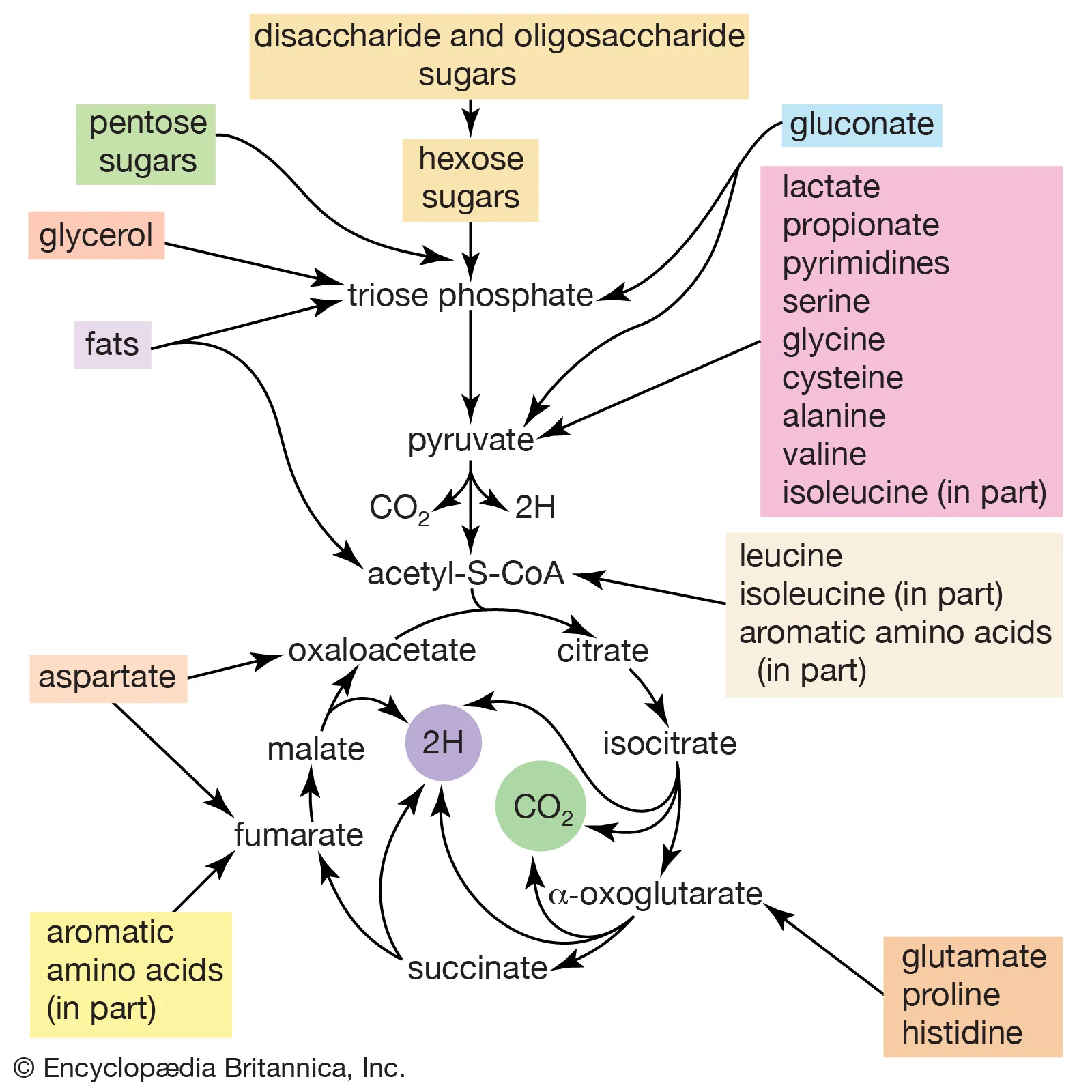
The hydrogens (and their electrons) are accepted by pyruvate to become lactate:
- Pyruvate + 2H → Lactate
It's difficult to reconcile with the assertion that "the Warburg Effect can only be explained by active leakage of electrons from mitochondria". Electrons in this case didn't even reach the mitochondria to be "leaked".
Since lactate is a negatively-charged molecule that's often exported with an additional proton (H+) as the positively-charged counterpart..
..which contributes to the extracellular acidification of cancer, we have the equivalent of a glucose molecule leaving the cell:
- Glucose: C6H12O6
2×Lactate: C6H10O6- 2×Lactic acid: C6H12O6
It's not that the elements of glucose are disappearing in enigmatic ways.
He went further: "the electron transport chain simply stopping [..] would also stop the consumption of substrate". A great deal of glucose is consumed in the cytosol at a high rate, without the need to involve the electron transport chain.
A gymnastic to make the claim reasonable would be to factor in anabolism and tie it in with glycolysis. After all, if glucose equivalents are exported from the cell as glucose is consumed, the cell will lack material to support growth.
Functional mitochondria of cancerous cells tend to be geared in favor of anabolism, and they adapt to find a way around metabolic steps that are inhibited, to redirect nutrients for synthesis. If a molecule has to undergo oxidation for this purpose, it may happen as far as needed to prepare it for anabolism.
"Although many cancer cells rely primarily on aerobic glycolysis for their energy, they still rely on mitochondria to produce precursors for fatty acid synthesis and other biosynthetic processes. How tumor cells with defective mitochondria produce the lipids necessary for proliferation has been unclear. Mullen et al. (2011) uncover new metabolic flexibility in cancer cells. Glutamine can drive citric acid cycle (CAC) reactions in reverse, such that reductive carboxylation yields acetyl-CoA for lipid synthesis. Glutamine-dependent reductive carboxylation has been recognized as a minor source of citrate in mammalian cells and as the major source of citrate and acetyl-CoA in P. falciparum, a parasite with limited respiration. By tracing the fate of carbons supplied to osteosarcoma cells by 13C-glucose or 13C-glutamine, the authors identify reductive carboxylation as the major source of [cytosolic] acetyl-CoA in ETC-deficient cancer cells. Although some tumors carry mutations in ETC components, oncogenic mutations are more commonly found in CAC enzymes like fumarate hydratase (FH). To test whether these types of mutations also favor glutamine-dependent reductive carboxylation, Mullen et al. (2011) examined the metabolism of renal tumor cells lacking FH activity. When cultured without glutamine, these cells stop proliferating. In the presence of glutamine, FH-deficient cells proliferate by employing both oxidative glutamine metabolism (a process well-known for replenishing CAC intermediates that are depleted under normal growth conditions) and reductive carboxylation of glutamine (contributing lipid building blocks). Despite the association between defective mitochondria and oncogenesis, this study highlights the central importance of mitochondria in cancer, even when they aren't generating ATP."
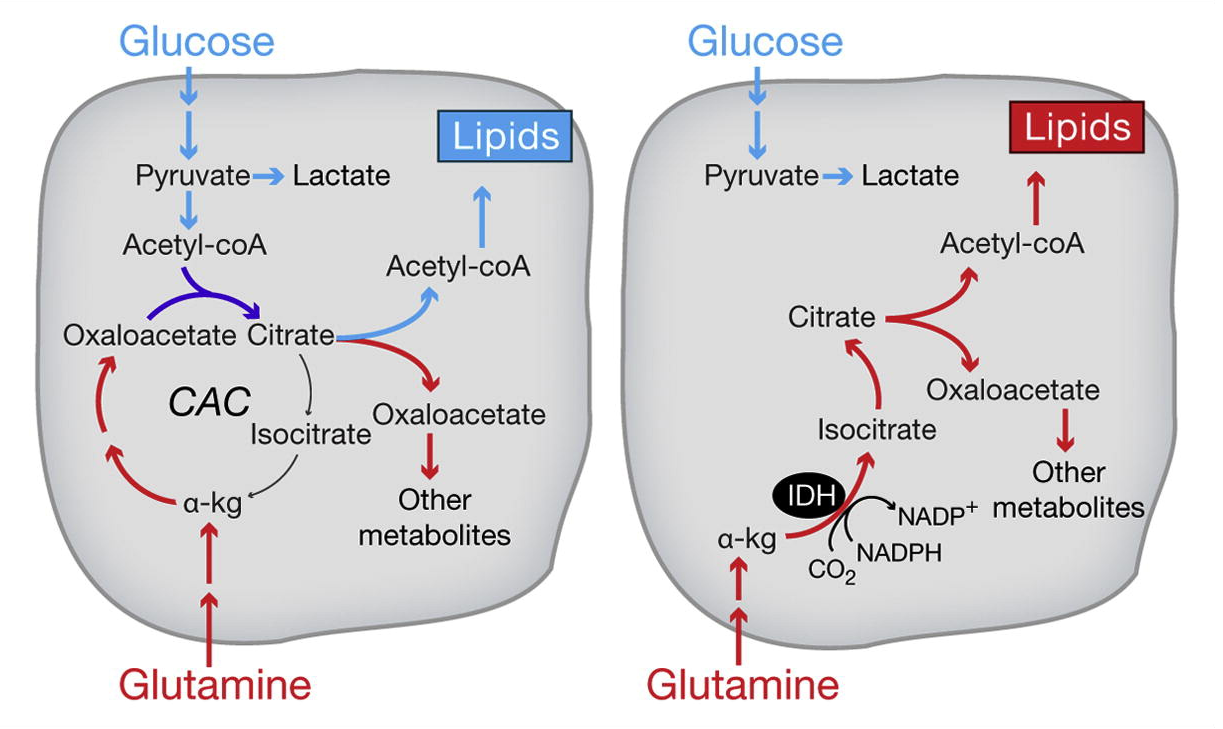
Both are cancerous.
- With intact respiration (left), glucose and glutamine can end up as citrate;
- With compromised electron transport chain (right), reflecting on a partial inhibition of the TCA cycle (that reinforces the inhibition of upstream pyruvate oxidation), glucose stays out of the mitochondria, that rely on glutamine through the reductive pathway in reverse to derive citrate.
- The oxidation of ketoglutarate is not shown (clockwise), but it's possible for the cycle to be limited in addition to the metabolism of fumarate.
In either case, "consumption of substrate" continues to occur (glucose and glutamine are used up) to form new molecules rather than undergoing complete oxidation.
- Reductive carboxylation supports growth in tumour cells with defective mitochondria
- Pyruvate carboxylase is required for glutamine-independent growth of tumor cells
Sate also wrote that "cancer cells consume a great deal of nutrition but produce very little energy".
Targeting energy metabolism to eliminate cancer cells
"The inappropriate proliferation of cancer cells requires high energy, and the cells generate ATP to satisfy the biomass production. The enhanced glycolytic rate in cancer cells is required not only to meet the need for energy but also to maintain the level of glycolytic intermediates needed for biosynthesis of macromolecules. The biosynthetic activities required for proliferating cancer cells involve high rates of nucleotide synthesis, amino acid synthesis, and lipogenesis."
Another important piece shared in conversations with my masters:
Revisiting the Warburg effect: historical dogma versus current understanding
"Aerobic glycolysis has been described as an inefficient means of energy metabolism, since the net production is only 2 moles of ATP per glucose molecule, whereas the total yield is 32(−33) ATPs (Mookerjee et al. 2017) from the complete oxidation of 1 glucose molecule. However, the speed of the cytosolic ATP generation is approx. 100 times faster (range: 20–300 times) than in mitochondria (‘low yield, but high-speed ATP production’). ATP provision per unit time is higher than in oxidative glucose metabolism as long as an adequate glucose supply is maintained in the extracellular compartment (Vaupel et al. 2019). In cases of greatly increased ATP demand by cancer cells, aerobic glycolysis can rapidly increase while OxPhos remains quite constant due to the much faster ATP production through the Warburg effect."
ATP/glucose:
- Cytosol 2:30 Mitochondria
- Cytosol 1:15 Mitochondria
ATP/time:
- Cytosol 100:1 Mitochondria
Therefore, increasing reliance on glycolysis is more than enough to compensate through speed for the lower yield per glucose, and meet the high energetic needs of cancer cells. Considering that the body tries to maintain a steady level of glucose in the circulation (independent of carbohydrate ingestion), if greedy cancer cells have access, it's a problem. But nothing that 700 mg of silicic acid a day with tartaric acid for sealing up the mitochondria can't cure.
Charnathan concluded his article with:
"As I do not have access to scientific institutions that normally distribute such discoveries please share this information wherever and with whomever you can to document my work and help people suffering from cancer."
It's unbelievable.
- I SOLVED THE WARBURG EFFECT (
